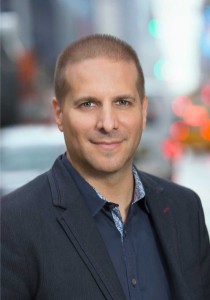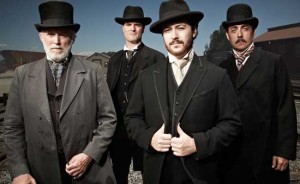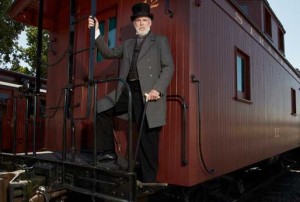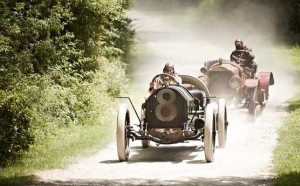![]()

The riveting eight-hour, four-part series chronicles the intertwined careers of five larger-than-life business figures – Cornelius Vanderbilt, John D. Rockefeller, Andrew Carnegie, Henry Ford and J.P. Morgan – who in railroads, oil, steel, autos and finance propelled this country’s industrial revolution and catapulted the U.S. manufacturing economy to worldwide dominance. All the while driven by ruthless competition and greed, they accumulated some of the largest personal fortunes that the world has ever seen.
“We were trying to do something different, but we didn’t know initially what it would look like,” said executive producer Stephen David. For him, the series was a self-described passion project that originated from his own youthful fascination with the era and its baronial entrepreneurs. “But the idea was always to do it as a kind of movie, mixing actor portrayals with archival material, and to make it look like it was filmed at the time of the industrial revolution.”
“It was tough because we were working with a lower level budget,” the producer noted. “A lot of the success we had in achieving a credible look and feel came from the hard work of the crew pulling off an overly ambitious project without reflecting our scarce resources.”

Meanwhile, costume designer Sarah Beers and her team have already received an Emmy – one of the advance awards handed out based on the judgment of professional peers – for outstanding costumes for a variety program or a special.
The series seamlessly knits together disparate elements and has a number of moving parts. First, dramatic reenactments by actors portraying the five titans with production design derived from a trove of Library of Congress photographs from the period. There is also voiceover narration throughout. And to provide contemporary context, episodes are interspersed with snippets of interviews with an A-list of talking heads such as former Federal Reserve chairman Alan Greenspan and Jack Welch, the ex-CEO of G.E.
 And CGI effects are deftly employed in major set pieces such as the construction by Carnegie of the country’s first steel bridge, which traversed a one-mile stretch of the Mississippi River, making it possible for the first time for trains to easily travel between the eastern and western halves of the U.S. A highlight of the episode is an elephant crossing the bridge to prove it is safe, with a cheering crowd following it.
And CGI effects are deftly employed in major set pieces such as the construction by Carnegie of the country’s first steel bridge, which traversed a one-mile stretch of the Mississippi River, making it possible for the first time for trains to easily travel between the eastern and western halves of the U.S. A highlight of the episode is an elephant crossing the bridge to prove it is safe, with a cheering crowd following it.
The scene, shot first as a trial use of special effects, was lensed on a parking lot in Brooklyn. “The only thing real was the elephant and the people, and the archway leading to the bridge – the rest was greenscreen,” explained David.
DP Lopez was responsible for the design of the shots and he coordinated closely with VFX firm Brainstorm Digital, which also does the special effects for Boardwalk Empire.
A desaturated look was the objective throughout, in order to set the visual mood back in time. “We wanted a bluish hue to give the show that industrial revolution feel,” said David. The shoot took place by and large in the late fall when light is more diffused and less bright “to get a kind of dirty look,” he added. A film camera was employed because film looks grainier, but a digital ARRI Alexa was used later to facilitate postproduction. A second camera crew was deployed for six months during postproduction to film the interviews with a score of historians and business figures.
 Filming on sets was done in West Virginia, with Harper’s Ferry and surrounding spots used for outdoors scenes. “Because of budget limitations, one of the tricks of the production designers was to dress the specific area we were going to film, not an entire house or room.” The two production designers, Ernesto Solo and Gonzalo Cordoba, along with costumer Beers worked hard to keep costs down. “[Solo, Cordoba and Beers] scoured every garage sale in West Virginia for anything they could find in furniture and clothing to keep within our overall budget,” he said.
Filming on sets was done in West Virginia, with Harper’s Ferry and surrounding spots used for outdoors scenes. “Because of budget limitations, one of the tricks of the production designers was to dress the specific area we were going to film, not an entire house or room.” The two production designers, Ernesto Solo and Gonzalo Cordoba, along with costumer Beers worked hard to keep costs down. “[Solo, Cordoba and Beers] scoured every garage sale in West Virginia for anything they could find in furniture and clothing to keep within our overall budget,” he said.
“What [the sound editors] did so well was to always allow the emotion of the scene to decide the sound design,” observed David. Cutting the show with film editors Tim Kelly, John Kilgour and Jonathan Soule took eight months and was the hardest part, he said. “It was very challenging to combine all the elements and we had nothing to copy so there was a lot of trial and error.”
David was once a screenwriter for the studios and wrote a lot of scripts based on actual events. “I’ve always loved that genre, the true story historical drama whether it’s a documentary or a movie,” he noted. “For me this is a favorite world to live in.” The producer of a dozen shows over the last five years, including current hit Redrum on the Investigative Discovery channel, a police procedural that goes back in time to solve forgotten crimes, also has two more historical mini-series in the works. Sons of Liberty, also for the History Channel, is about the American Revolution and the country’s founding fathers. And National Geographic Channel recently greenlit American Genius, which will focus on Benjamin Franklin, Alexander Graham Bell, Steve Jobs and Mark Zuckerberg, among others.





